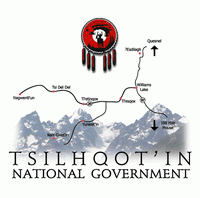 Recognizing the intangibles of the new relationship. SPP link here
Recognizing the intangibles of the new relationship. SPP link here
Yesterday, the Supreme Court of Canada confirmed title to the Tsilhqot’in Nation.
The Tsilhqot’in Nation in British Columbia have always possessed aboriginal title to approximately 2,000 square kilometres of land. The decision – the first to recognize aboriginal title to specific real property – explicitly renounces the Euro-British doctrine of terra nullius. That false, racist, white supremacist notion claimed that no one owned the land before the Crown claimed it, and the Court has determined that this has no basis in Canadian law: https://scc-csc.lexum.com/scc-csc/scc-csc/en/item/14246/index.do
The Crown (as the embodiment of the State) is required to obey the letter and spirit of its own treaties of shared rule, originating with the Royal Proclamation of 1763.
‘ “This is the fulfillment of that promise, held out by the Crown 250 years ago.”
Brian Slattery, Osgoode Hall Law School’
Aboriginal Title
- Control of ancestral lands and the right to use them for modern economic purposes, without destroying those lands for future generations.
- Government can create works that show overwhelming value, but have to show substantive consultation and must reconcile those needs with aboriginal rights to title.
- The Court explicitly states that the decision holds for all lands that were not ceded to the Crown by treaty.
- Nearly all of BC.
Sacred Priorities Protocol – Could this be a way forward?
I’ve been networking a respectful technical solution through industry since 2010.
There have been complaints that intangible cultural values are not scientific and therefore should not be allowable at Environmental Review Boards.
SPP proposes a method to have local communities assign values to intangible values, such as landscapes, as scientific/technical values…as a means to find win-wins vs. the old Might Makes Right way of resource extraction.
It is written here at a granular level, with an example and flowchart, for use at the very start of industrial development planning. Years and millions of dollars before a project is assessed by regulators. For example, with mining, after test drilling has identified an economic ore body but before the start of ore body extraction planning.
- SPP flows out of watching mining projects fail across in BC.
- The procedure could be used to create technical and governance win-win expertise.
- Expertise exportable around the globe.
But to work, any Protocol must be centred in the good earth of respect for First Nations Law and Title.
And acknowledgement that when we Europeans and British arrived, we privatized property that wasn’t ours.
If we don’t acknowledge our own law, why should First Nations acknowledge it either?
Dave Huer
